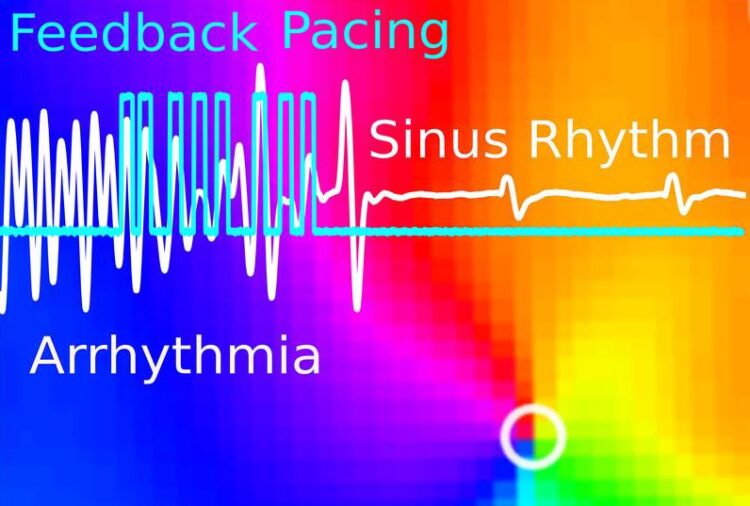Gentle defibrillation for the heart

A cardiac ventricular arrhythmia can be converted to a normal sinus rhythm (white line) by using a sequence of light pulses (blue line) in an optogenetic mouse heart.
(c) Biomedical Physics Group / MPI-DS
Using light pulses as a model for electrical defibrillation, Göttingen scientists developed a method to assess and modulate the heart function. The research team from the Max Planck Institute for Dynamics and Self-Organization (MPI-DS) and the University Göttingen Medical Center thus paved the way for an efficient and direct treatment for cardiac arrhythmias. This may be an alternative for the strong and painful electrical shocks currently used.
Cardiac arrhythmias account for around 15-20% of annual deaths worldwide. In case of acute and life-threatening arrhythmias, defibrillators can be used to restart the regular beating of the heart. A strong electrical pulse brings cardiac activity to a brief standstill before it can be resumed in an orderly way. Whereas this treatment can save lives very effectively, the strong electrical pulses can also have negative side effects such as damage of the heart tissue or strong pain.
“We developed a new and much milder method which allows the heart to get back into the right rhythm,” says Stefan Luther, Max Planck Research Group leader at the MPI-DS and professor the University Göttingen Medical Center. “Our results show that it is possible to control the cardiac system with much lower energy intensity,” he continues.
To test their method, the scientists used genetically modified mouse hearts that can be stimulated by light. In this setting, a sequence of optical light pulses is triggered using a closed-loop pacing algorithm. Each pulse is triggered in response to the measured arrhythmic activity. With this pacing protocol, the team was able to effectively control and terminate cardiac arrhythmias even at low energy intensities that do not activate the heart, but only modulate its excitability.
“Instead of administering a single high-energy shock to restore normal heart rhythm, we use our understanding of the dynamics of cardiac arrhythmias to gently terminate them.” explains Sayedeh Hussaini, first author of the study. “This results in a subtle treatment method with far less energy per pulse, more than 40 times less compared to the conventional strategy” she reports.
The research team will also use these findings to improve the control of arrhythmias using electrical pulses. This may result in advanced defibrillators causing less pain and side-effects for patients.
Wissenschaftliche Ansprechpartner:
Prof. Dr. Stefan Luther
Max Planck Institute for Dynamics and Self-Organization
stefan.luther@ds.mpg.de
Originalpublikation:
https://pubs.aip.org/aip/cha/article/34/3/031103/3278936/Efficient-termination-o…
Weitere Informationen:
Media Contact
All latest news from the category: Medical Engineering
The development of medical equipment, products and technical procedures is characterized by high research and development costs in a variety of fields related to the study of human medicine.
innovations-report provides informative and stimulating reports and articles on topics ranging from imaging processes, cell and tissue techniques, optical techniques, implants, orthopedic aids, clinical and medical office equipment, dialysis systems and x-ray/radiation monitoring devices to endoscopy, ultrasound, surgical techniques, and dental materials.
Newest articles
Faster, more energy-efficient way to manufacture an industrially important chemical
Zirconium combined with silicon nitride enhances the conversion of propane — present in natural gas — needed to create in-demand plastic, polypropylene. Polypropylene is a common type of plastic found…

Energy planning in Ghana as a role model for the world
Improving the resilience of energy systems in the Global South. What criteria should we use to better plan for resilient energy systems? How do socio-economic, technical and climate change related…

Artificial blood vessels could improve heart bypass outcomes
Artificial blood vessels could improve heart bypass outcomes. 3D-printed blood vessels, which closely mimic the properties of human veins, could transform the treatment of cardiovascular diseases. Strong, flexible, gel-like tubes…





















